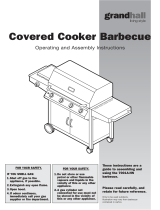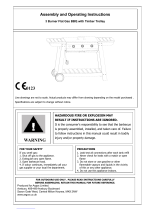
4 FOR BUILT-IN UNITS ONLY
FOR BUILT-IN UNITS ONLY
The SL4000 comes in both trolley-mounted and built-in
models. These two pages contain information relating to
setting up built-in model only.This appliance is designed
to be used with a gas cylinder not exceeding 9KG (20lbs)
capacity.
About The Cylinder Enclosure
If the gas for your barbecue is to be supplied by a portable
gas cylinder, you will need to ensure that adequate provision
is made to house the cylinder safely� The following must be
adhered to:
Keep out of heat: The cylinder and hose must be sheltered
from the sun’s direct heat� The flexible PVC hose assembly
supplied must not be exposed to temperatures in excess of
60°C (140°F)� DO NOT allow the hose to come in contact with
the hot surface of the barbecue body�
Keep cylinder upright: The cylinder must be housed
securely� It must remain upright at all times� It can be either
attached to a firm vertical wall by a cylinder bracket, or
stored on a firm level base�
Requirements for cylinder base: If the cylinder is to be
stored on a flat base, the base must be made from non-
combustible material� Soil or grass is not an appropriate
surface� Ensure there is adequate drainage, and that water
cannot collect around the cylinder�
Requirements for cylinder enclosure: Where the cylinder
is to be kept inside an enclosure, you must ensure there is
200 square centimetres of open ventilation at each of the top
and the bottom of the enclosure, for each cylinder stored in
it� This prevents leaking gas from building up in a confined
space� Gas vapour is highly explosive and can cause serious
bodily injury or damage to property if allowed to accumulate
in a confined space and ignited�
ventilation
The Barbecue Housing
We recommend that this installation be done in a masonry
structure and carried out by a professional tradesperson�
Other non-combustible material such as Hardiplank,
Villaboard with metal studs may also be used�
• Must have a minimum clearance from combustible
materials of all sides of the barbecue of 450 mm (18”)�
• This appliance must not be installed under or on
any combustible material� Minimum clearance from
combustible construction materials to all sides of the
appliance is 450mm (18”)�
Warning: Contact your local municipality for any building
codes regulating the installation of outdoor barbecue
appliances� Outdoor installations must conform to local
codes or, in the absence of local codes, with:
USA: National Fuel Gas Code, ANSI Z223�1/NFPA 54
CAN: B149�1 Natural Gas & Propane Installation Code
AUST: Australian Standards Code AS: 5601
as well as the requirements of any local council, gas,
electricity authority or other statutory regulation�
The Cavity
Your barbecue has been designed to sit into a cavity or
cutout rather than be placed directly onto a flat surface� It is
important that the dimensions of the cavity conform exactly
to those listed on page 21� This will ensure the barbecue sits
correctly in the cavity, and that the barbecue has sufficient
ventilation to operate efficiently and safely�
In creating the cavity, you should ensure that you have
convenient access to the gas connection point and
associated hardware:
• If the gas for your barbecue is supplied by a portable gas
bottle, you will need access to the gas connection point,
the gas hose and the gas cylinder at all times�
• If the gas for your barbecue is supplied by a fixed piped
gas supply (either natural gas or 45kg LPG cylinders),
you will need access to the gas connection point, the
piping and the shutoff valve�
Putting The Barbecue Into Place
Lower the barbecue onto the brickwork, but do not push
back into its final position - you will need to ensure you
can access the screws towards the front of the barbecue
side panel�
Attach the right and left side facia panels� The fixing
screws should already be in place at each side of the
barbecue frame�
Tighten the screws to
secure the facia panels�
Push the barbecue back
to its final position�





















